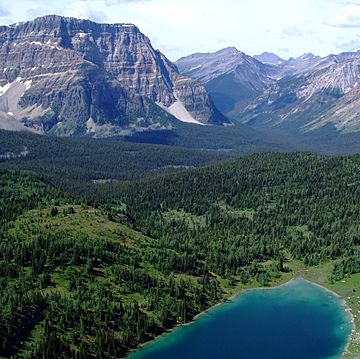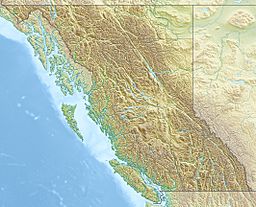Mount Watson facts for kids
Quick facts for kids Mount Watson |
|
|---|---|

Mount Watson upper left
|
|
| Highest point | |
| Elevation | 2,955 m (9,695 ft) |
| Prominence | 165 m (541 ft) |
| Parent peak | The Marshall (3180 m) |
| Geography | |
| Location | Mount Assiniboine Provincial Park British Columbia, Canada |
| Parent range | Canadian Rockies |
| Topo map | NTS 82J13 |
| Geology | |
| Age of rock | Cambrian |
| Type of rock | sedimentary rock |
| Climbing | |
| Easiest route | Scrambling |
Mount Watson is a tall mountain peak in British Columbia, Canada. It stands about 2,955 meters (or 9,695 feet) high. You can find it in the amazing Mount Assiniboine Provincial Park, which is part of the Canadian Rockies. The closest mountain that is taller than Mount Watson is called The Marshall, located about 2 kilometers (1.2 miles) to the southeast.
Contents
About Mount Watson
Mount Watson is a popular spot for outdoor adventures. Its highest point is a summit, which is the very top of the mountain. The easiest way to reach the top is by Scrambling, which is a mix of hiking and easy climbing.
How Mount Watson Got Its Name
The mountain was named in 1924 after a brave leader named Sir David Watson. He was a general who commanded a large group of soldiers, the 4th Canadian Division, during World War I. The name was officially approved on March 31, 1924, by the Canadian government's geographical names board.
The Rocks of Mount Watson
Mount Watson is made of a type of rock called sedimentary rock. This kind of rock forms over a very long time from layers of sand, mud, and tiny bits of sea creatures that settle at the bottom of ancient seas. The rocks in Mount Watson were formed during a time called the Cambrian period, which was hundreds of millions of years ago. Later, huge forces from inside the Earth pushed these layers of rock upwards, creating the mountains we see today. This process is called the Laramide orogeny.
Weather on the Mountain
Mount Watson has a subarctic climate. This means it has very cold and snowy winters. Temperatures can drop below −20 °C (or −4 °F), and with the wind, it can feel even colder, sometimes below −30 °C (or −22 °F). Summers on the mountain are usually mild. The snow and rain that fall on Mount Watson eventually flow into smaller streams that join the Mitchell River.



